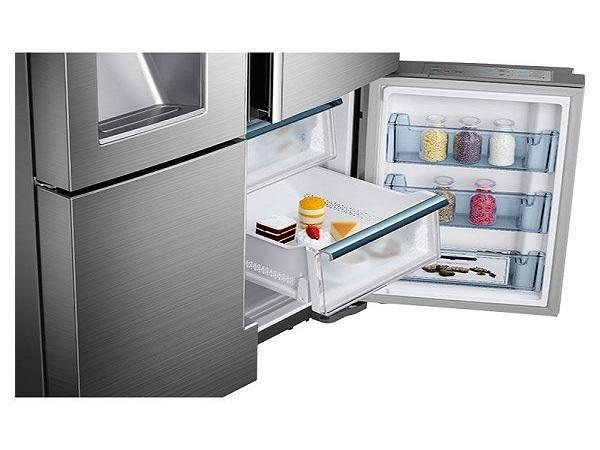
5 Best Way to Clean Your Refrigerator
Your refrigerator sees a lot of action every day, and not all of it's pretty -- leftover chili splatters; forgotten veggies turn slimy. Eventually, the icebox looks like an abstract painting in a modern art museum.
Every now and again you’ll need to clean the inside of your refrigerator, not least because, despite the low temperatures, microorganisms can still multiply.
Refrigerators will inevitably get a little messy – perhaps jam gets stuck to one of the shelves or maybe juice spurts out in the door shelving, and it’s obviously time to reach for the cleaning cloth! Yet, even if your fridge isn’t visibly dirty, we still recommend that you clean it every four weeks or so because, after all, you’re storing fresh food here!
Preparing for the Purge
Cleaning out the refrigerator, while a sloggy, smelly, often grotty task, doesn’t require a whole lot by way of specialty products. You should, however, gather a few items that will help to streamline the process and, hopefully, cut down on the ick-factor of disposing of so many long since forgotten foodstuffs.
Here are some of the things you might need for your clean-out:
• Trash bags
• Rubber or disposable gloves
• Cleaning solution
• A Dobie Pad, sponges, rags or paper towels
If you have a fridge-freezer without NoFrost or a refrigerator with a freezer compartment you should leave it to defrost for several hours before you clean it out.
Note: For Every Brands have their specific cleaning guidelines. Check Best Refrigerators with all details.
Start by Taking Everything Out:
You can do this all at once or in sections. We prefer to do it all at once. The thought of the food sitting out helps me do everything faster. Set aside two areas for setting items down: one area for things that need to be cleaned out (outdated leftovers in tupperware, for example) and another area for items that need to be put back into the fridge. Anything that needs to be discarded that's not in a container you want to keep goes straight into the trash, of course.
Do a First Pass at Inventorying Your Foodstuffs:
Cleaning the fridge is a good time to organize the contents to make them more visible and accessible. Food that's easily seen and reached is less likely to be overlooked and turn into a future source of odors. Also, spacing foods to allow a free flow of chilled air helps to keep them at their peak.
Transfer highly perishable items like milk, raw chicken or pork to a cooler or the freezer for the duration of your fridge-cleaning efforts (check those items for spoiling and toss anything that’s gone off). Then set aside bottles, jars, produce and the like, reviewing the food to weed out rotting, moldy or unused things that should go into the trash.
Last, review leftovers. This will be, perhaps, unpleasant! Gloves can help to make scooping out old lasagna or soggy salad less disgusting. And, as facile as it sounds, holding a deep breath while decanting moldy foods into the trash will help minimize any stomach-turning.
Cleaning the interior:
Reaching into the recesses of the fridge to wash down racks, shelves and drawers makes a good stretching routine. The best way to clean the interior is with a microfibre cloth, warm water and a little washing-up liquid or pH-neutral detergent.
While these pieces take a bath, take a toothbrush with cleansing powder to brackets and gaskets. Bacteria can hide in these and other hard-to-reach areas, while the moist, airtight environment formed by door seals makes them prime targets for mold. Dry all pieces well to discourage these unwelcome microbial guests.
After cleaning, wipe out the interior using clean water and dry it with a cloth. It’s not uncommon for household advice websites to suggest cleaning your refrigerator with vinegar: we strongly advise you not to do this as vinegar can sometimes corrode plastics. You should also avoid using scouring pads, abrasive sponges and other aggressive cleaning agents and aids.
Cleaning the exterior
Suitable cleaning of the outside of your appliance depends on the material from which it is made.
Plastic exteriors: Clean with a little lukewarm water and washing-up liquid.
Stainless steel doors: These have a SmartSteel finish, which must be treated with care. Wipe them with a soft, clean cloth. If it is necessary to remove tough dirt, use a little water or a pH-neutral cleaner. Please note: You must not use stainless steel cleaner on SmartSteel surfaces as this can damage the SmartSteel finish.
Have Cleaning Supplies Ready
Too often, a messy refrigerator falls victim to the "out of sight, out of mind" syndrome. The food's behind closed doors most of the time, after all. By stashing a cleaning kit nearby, you may be more tempted to clean up accidents as they occur.
Why the hurry? For one thing, cleaning up fresh spills saves the time and effort of scrubbing after they've dried. It may also save you trips to the bathroom and even the emergency room. A glob of deviled ham can harbor a thriving colony of listeria, the bacteria that cause listeriosis, a foodborne illness marked by nausea and diarrhea, fever and chills.
- Contractor Ram
- Tags: How to clean Refrigerator